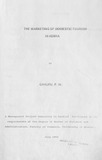| dc.description.abstract | The primary objectives of the study reported here were to:
determine the extent to which marketing mix variables are used in
marketing domestic tourism; examine the influence of various factors
on the marketing of domestic tourism; and determine the demographic
and socio-economic characteristics of domestic tourists.
To satisfy these objectives a descriptive research was
}tonducted. The relevant data were collected from salllplesdrawn from
the Ministry of Tourism and Wildlife, the private sector, and
domestic tourists. The data were collected using both structured and
unstructured questionnaires. Once collected, the data were ana lysed
by means of summary statistics like percentages, proportions and
cross tabulations. The Kruskal Wallis H-test and Likert profile were
also used to test for any differences between various sub-samples.
The findings from these analyses led to several conclusions.
First, the domestic tourism market in Kenya is still very young.
The industry does not appear to attach a lot of importance to this
market. This is because ~ clear framework for a marketing mlX for
Kenya's domestic tourism does not exist. Some consideration was
however being given to the various areas of marketing decisions;
product, price, place, promotion, personnel, physical facilities,
process management and other related issues like segmentation,
marketing research, and joint marketing efforts on domestic tourism . . Second, there are divergent aims between the firms in the
industry and the ministry. The private sector in the industry is
profit t motivated while the ministry has both social and economic
benefits that accrue to the country as their major objectives.
Third, the marketing efforts of both the firms and the ministry
were~poorly coordinated. There was also no meaningful co-operation
between the firms and the ministry and among st the firms themselves.
Some cooperation was found among the budget hotels but it was not
enough. The lack of cooperation led to duplication of resources
especially among the major hotel chains and travel firms.
Fourth, marketing domestic tourism was found to be immature with
the major hotel chains and travel firms associating it with the low
international tourism season.
Fifth~ the firms were found to be product oriented in providing
products to customers.
The major problems facing domestic tourism were found to include
low levels of income among the local people, lack of awareness, high
prices of tourist products, lack of promotion, general economic
instability and'lack of information on the local market. It was
suggested that prices should be reduced not only for accommodation
and transport but also for peripheral items like food. The other
problems also need to be addressed if domestic tourism is expected to
mature.
The study was limited by the shortage of resources.
non-cooperation of some firms and the period within which the
:conducted were also a problem. | en |

